In late Autumn 2024, the DSNY Containerization Pilot Program Final Rules were published. These rules expand the city’s containerization policies for buildings with 10 or more units in Manhattan Community District 9, with the goal of expanding citywide after the program ends. While requirements for residential buildings with 1 – 9 units are in effect citywide (as of November 12, 2024), the pilot program addresses larger residential properties specifically.
If your team has buildings in Manhattan CD 9, below are the basics of what you need to know. If you don’t have properties in this community district, read on anyways – it’ll give you an idea of what to expect when the program potentially expands.
Where Does The Program Take Place?
The city chose Manhattan Community District 9 to kick off the pilot program, including West Harlem, Hamilton Heights, Manhattanville, and Morningside Heights. Per the finalized rules, this neighborhood was chosen for the following reasons:
it is one of the rat mitigation zones designated by the Department of Health and Mental Hygiene and it offers a very diverse set of building types and streetscapes. A portion of this area was also the subject of a much smaller scale assessment for containerization that resulted in fewer 311 rat complaints in the area.
Containerization is a big part of the city’s efforts for rat mitigation, so it makes sense that the pilot program centers on one of the city’s mitigation zones.
When Is The Program In Effect?
The pilot program has an “implementation date” of June 1, 2025, and ends a year later on May 31, 2026.
The implementation date is the official date where all properties in CD 9 will have to comply with “applicable containerization requirements as provided.” The rules also mention that the end date marks the time where buildings no longer have to comply with the pilot program rules, and the DSNY will remove stationary on-street containers. That said – the plain language explainer does note that “Future rules for a permanent program could provide for stationary on-street containers in the pilot area to remain in place after the pilot end date.”
That’s all to say – a year is a long time in compliance, so it’s possible the end date may overlap with more permanent, similar rules. Still, it’s important to keep in mind.
What is a SOSC?
A term you’ll see frequently in the new rules is SOSC – a stationary on-street container. SOSCs are containers for storage and collection of residential waste, procured by the DSNY and placed in the public right of way in consultation with the DOT. Per Crain’s, these initial bins will be provided by Contenur and based on the OVAL model here. A mini-pilot program started in Hamilton Heights last year using similar containers.
Based on the city’s updated site, these will be generally referred to as Empire Bins.
Process For Buildings With 31+ Units
Per the program, all residential properties in CD 9 with 31 or more dwelling units must use SOSCs for trash disposal and collection.
Residential buildings in this category that receive DSNY collection, or are applying to receive DSNY collection, are not required to use SOSCs if:
- The building receives off-street collection, including collection from inside a loading dock; OR
- DSNY determines that the building’s circumstances “warrant a different containerization method or alternative set-out method”
- DSNY will perform independent analysis and inform any buildings of the methods it must utilize no later than 2 months prior to 6/1/25
- Any methods referenced above must be in place by that date
During the application period (December 15, 2024 – January 31, 2025), “all residential buildings containing 31 or more dwelling units located in area must provide building ownership and applicable contact information using a form available on the Department’s website.” The Waste Manager Details form can be filled out here.
Filling out the form is critical – per the DSNY’s website, you “MUST provide this information by January 31, 2025, or you WILL NOT BE ABLE TO ACCESS your Empire Bins for trash setout starting June 1, 2025.” If you manage multiple properties, a separate form is required for each property.
Process For Buildings With 10 – 30 Units
For buildings with 10-30 units, there are three paths to compliance:
- Buildings must set out refuse for DSNY collection using approved bins (rigid receptacles with tight-fitting lids not exceeding fifty-five gallons in size);
- UNLESS such building is directed by the DSNY to use an alternative method, OR
- If such building is approved by the DSNY to use a SOSC
Similar to larger buildings, DSNY may determine that alternate collections methods are required and notify properties two months in advance of the implementation date. Alternatively, buildings with 10 – 30 units may opt-in and apply to place refuse in a SOSC. Any applicants that are denied will be notified in writing, and must then either use approved bins or alternate methods as specified. The opt-in form can be accessed here.
Additional Requirements & Resources
- Change in ownership for buildings that use SOSCs will require the new owner to notify DSNY immediately via a form on their website
- If a SOSC is temporarily removed by the DSNY or DOT, or is otherwise inaccessible “through no fault of the building owner or agents,” buildings must set out refuse in a manner determined by the DSNY
- Residential buildings utilizing SOSC must ensure that they are “kept clean, well-maintained, and clear of trash, debris, graffiti, vermin, food scraps, and unsanitary conditions. Such residential building must also ensure that the area of the roadway extending 1 1/2 feet beyond each side of such stationary on-street container is kept clean.”
The DSNY published a main page for the Pilot Program here, including breakdowns for each property group and all links to opt-in forms.
We’ll continue to update this post with additional changes and resources as they’re announced. Stay tuned!




